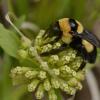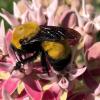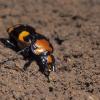
In the 1970s it was believed that Blackburn’s sphinx moth was extinct. However, it was rediscovered in 1984 when a single population was found on Maui. Subsequently, populations have also been discovered on Kaho’olawe and Hawaii. Threats to the moth include loss and degradation of habitat from urban and agricultural development, invasion by non-native plant species, habitat fragmentation and degradation, increased wildfire frequency, and disturbance by grazing cattle. In addition, non-native parasitoids and insect predators have directly impacted moth populations and significantly reduced the species’ range. Blackburn’s sphinx moth is also susceptible to over-collection for personal collections or for trade.
Taxonomic Status
(Lepidoptera: Sphingidae: Sphinginae: Sphingini)
Manduca blackburni (Butler), 1880.
With a wingspan of up to 5 inches (12 cm), Blackburn’s Sphinx Moth is Hawaii’s largest native insect. Like other sphinx moths, it has long, narrow forewings and a thick, spindle shaped body that tapers at both ends. The moth is grayish brown in color with black bands across the top margins of the hindwings and five orange spots along each side of the abdomen. The moth’s caterpillar is large and occurs in two color morphs, bright green or gray. Both morphs have scattered white speckles throughout the back and a horizontal white stripe on the side margin of each segment.
Larvae of Blackburn’s sphinx moth feed on plants in the nightshade family (Solanaceae). The native host plants are trees within the genus Nothocestrum (aiea) on which the larvae consume leaves, stems, flowers, and buds. However, many of the host plants recorded for this species are not native to the Hawaiian Islands. These include commercial tobacco (Nicotiana tabacum), tree tobacco (Nicotiana glauca), eggplant (Solanum melongena), tomato (Lycopersicon esculentum), and possibly, Jimsonweed (Datura stramonium).
In general, sphingid moths can develop from egg to adult in as little as fifty-six days but pupae may remain in a state of torpor (inactivity) in the soil for up to a year.
Blackburn’s sphinx moth adults have been documented feeding on nectar of the native Hawaiian morning glory species, Ipomoea indica. It is expected that the Hawaiian native caper (Capparis sandwichiana) and wild leadwort (Plumbago zeylanica) are also likely food sources. All three plant species bear flowers that possess some characters suggestive of moth pollination, including opening at night, pale coloration, or a strong fragrance.
By the 1970s Blackburn’s sphinx moth was thought to be extinct. It was rediscovered on Maui when a single population was found in 1984. Subsequently, populations have been discovered on two other islands, Kaho’olawe and Hawaii.
Historically the moth has been recorded from the islands of Kauai, Kahoolawe, Oahu, Molokai, Maui, and Hawaii and has been observed from sea level to 1,525 meters (5,000 feet) elevation. Most historical records were from coastal or lowland dry forest habitats in areas receiving less than 127 centimeters (50 inches) annual rainfall.
Xerces Red List Status: Critically Imperiled
Other Rankings:
Canada – Species at Risk Act: N/A
Canada – provincial status: N/A
Mexico: N/A
USA – Endangered Species Act: Endangered
USA – state status: None
NatureServe: G1
IUCN Red List: N/A
Reports by early naturalists suggest this species was previously widespread and abundant, at least during European settlement, on nearly all the main Hawaiian Islands. More recent sampling results indicate that moth population numbers are small. However, at this point, no reasonably accurate estimate of population sizes have been possibly due to the adult moths’ wide-ranging behavior and it’s the species overall rarity.
Blackburn’s sphinx moth is federally listed as endangered. None of it known populations are entirely protected from the numerous factors threatening the species’ recovery, and the moth is endangered throughout its range. Critical habitat has been designated for the moth and a draft recovery plan has been developed.
Threats to Blackburn’s sphinx moth can be placed in two categories, impacts on habitat and direct impacts on moths themselves. The moth’s habitat is being lost and degraded by urban and agricultural development, invasion by non- native plant species, habitat fragmentation and degradation, increased wildfire frequency, and grazing and trampling by cattle. Direct impacts to the moth are from non-native parasitoids and insect predators. These have reduced populations and have significantly reduced the species’ range.
Because of the small sizes of known populations, Blackburn’s sphinx moth is also susceptible to over-collection for personal collections or for trade.
The principal conservation need for this species is protection of habitat. The U.S. Fish and Wildlife Service is currently a partner in a dry forest restoration project on State lands in the same area that the North Kona population of the moth occurs. While no conservation efforts specifically for the moth are currently underway on Kaho’olawe, the State of Hawaii, the Kaho’olawe Island Reserve Commission, and the U.S. Navy are aware of the presence of this species and have sponsored surveys to identify the distribution of the moth on the accessible parts of the island.
The US Fish and Wildlife Service is currently funding research examining the life history, captive rearing, and conservation biology of Blackburn’s sphinx moth.
Funasaki, G. Y., P. L. Lai, L. M. Nakahara, J. W. Beardsley, and A. K. Ota. 1988. A review of biological control introductions in Hawaii: 1890 to 1985. Proc. Hawaii. Entomol. Soc. 28:105-160.
Gagne, W. C. and F. G. Howarth. 1985. Conservation status of endemic Hawaiian Lepidoptera. Pp. 74-84 in Proceedings of the 3rd Congress of European Lepidopterologists. Cambridge. 1982. Societus Europaea Lepidopterologica, Karluhe.
Howarth, F. G. 1983. Biological control: panacea or Pandora’s box? Proc. Hawaii. Entomol. Soc. 24:239-244.
U.S. Fish and Wildlife Service. 2000. Endangered and threatened wildlife and plants: determination of endangered status for Blackburn’s sphinx moth from Hawaii. Federal Register 65(21):4770-4779.
U.S. Fish and Wildlife Service. 2002. Endangered and threatened wildlife and plants; designation of critical habitat for Blackburn’s Sphinx Moth. Federal Register 67(114):40633-40657.
U.S. Fish and Wildlife Service. 2003. Draft recovery plan for the Blackburn’s Sphinx Moth (Manduca blackburni). Region 1 U.S. Fish and Wildlife Service. Portland, Oregon.
Profile prepared by Scott Hoffman Black, The Xerces Society for Invertebrate Conservation
Citation
Black, S. H. 2005. Species Profile: Manduca blackburni. In Shepherd, M. D., D. M. Vaughan, and S. H. Black (Eds). Red List of Pollinator Insects of North America. CD-ROM Version 1 (May 2005). Portland, OR: The Xerces Society for Invertebrate Conservation.





